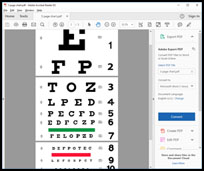This morning someone sent me this question. Like many folks who’ve started to explore the Bates Method, he’s experimented with leaving his glasses off, and maybe even read a vision improvement book or two, yet he was confused about this fundamental concept. He wrote that he knew he was supposed to see a central point clearly and everything else less clearly, “… but when I try to look like that it seems somehow very limited, like I am missing out on a lot of things.”
This student has intellectually grasped the concept of central fixation, that only the central point of his focus (the point “directly regarded”, Dr. Bates called it) will be seen with the greatest clarity. Everything else surrounding it will be seen less clearly. The farther away from the central point, the less clear something will be. Yes, this is exactly how normal healthy sight functions. However he’s coming to the wrong conclusion that all he’ll be able to see this way is a point and a small area surrounding it. Of course he wants to see the entire scene in front of him.

Unfortunately, if you’ve worn glasses for a while, it’s likely you’ve unknowingly trained yourself to see a large central area equally clearly, and your periphery hardly at all. Wearing glasses expands your idea of “the center” and shrinks your periphery. The strongest correction will always be in the center of the lens of your eyeglasses. This trains your eyes not to move too far away from that spot, because the view will be more blurry. So you learn to ignore your periphery. Plus the frames of your glasses are a natural boundary, fencing in your vision even more, keeping your gaze away from the edges of your visual field.
Several years ago I belonged to a gym with a water fountain right outside the entrance to the men’s and women’s locker rooms. A few times a week I saw gym members wearing glasses bend down to drink from the fountain, stand up again, turn to go somewhere, and walk right into someone else! People who wear glasses are naturally limiting their peripheral vision. Unfortunately, they often retain this limitation even when they take off their glasses, until they start training themselves to see more.
As students progress on a vision improvement journey, they start to realize and see that their central vision is the most clear, even though it may not be perfectly clear yet. In the beginning they may have to look some distance away from the center to notice the difference between center and periphery. Try looking straight ahead, and holding a finger at the side of your face. Can you see it, without turning your gaze to it? That’s your peripheral vision. See how far you can move it back toward your ear before you lose awareness of it. Also, if you hold a finger from the other hand straight in front of your eyes in your central vision, notice how the peripheral finger is more blurry than the central one. Play with bringing the peripheral finger closer to the center, noticing how it gets clearer, yet the other finger in your central vision is always more clear than the peripheral one.
New vision improvement students often have the same concern as the one who wrote to me, who said his central view is “limited”. Students are afraid that they’ll be missing something important if they look with central fixation. First, as I mentioned earlier, they can think their central vision is all there is, since they’re accustomed to ignoring the periphery. So the thought of having their visual field reduced to a small area is understandably scary. What they’re not realizing is that they’ll see the center most clearly, but will still see everything else too, just not with as much clarity.
The final missing piece to this is movement. The healthy eye is moving all the time, tiny little micro-motions called saccades. I like to think of these as the eyes scooping up all those photons which carry the colors and light ray information, to bring this data to the brain and enable the visual image to be painted there for you to see. Look at the sparkling eyes of a healthy child, or someone with normal vision — healthy eyes are not still!
So this false fear of “missing something” if your central vision only covers a small area is quickly relieved once you realize you can move your gaze and find a new center! The way the eye is supposed to work is to have the central vision focus on what you’re most interested in, scanning over it to pick up more and more detail, with your peripheral vision engaged also. Then when something more interesting shows up in your periphery, you’ll turn your central vision to that, to see it more clearly! A perfect design.
To practice central fixation, just easily notice. Notice that the center of your vision is the most clear, and the periphery is visible to you, yet not as clear as the center. Then turn your central gaze to that formerly peripheral view, and it will become clearer. Or you could look at 2 pencils side by side on your desk, or a little apart from each other, and notice how the one you look directly at is clearer. That’s it! Notice where your visual attention is, where you have chosen to put your focus, and that you’re seeing most clearly where you’re looking, and that everything else around that is less clear. Easy peasy. A child can do it.
I wore strong glasses, then contact lenses, from age 5 into my 40s. While making many mistakes, eventually l learned how to improve the way I use my eyes and to see in a more relaxed, healthy manner. It is my pleasure to coach others to do the same. Visit me at https://NancyLNeff.com.


Hi Nancy. If I try to practice central fixation in this way also the eye goes into a stare.i have read online also about fixational eye movements like drifts,tremors and microsaccades but still I feel my eye is immobile stiff and staring.also when I stare I try to see entire thing in my visual field clearly which dr bates called as eccentric fixation.can you help me to understand how I can break the stare and get eye back to normal motion and how i cure eccentric fixation and get central fixation
Hello Sriram. Central fixation should be easy and without effort, gently noticing without straining or trying to see, just inviting in the clarity as you move from point to point, seeing what you look at directly as the most clear. Some movement practice like with the Long Swing may help you to break up the staring habit. This article may give you something to play with: https://www.iblindness.org/1344/the-long-swing-and-me/. Easy does it!
Hi Nancy.thanks for the response.but as you have mentioned in the article when I practice central fixation I am able to consciously see that I can see only a small area very clearly.that itself is actually making me to see a large area clearly as if my eye is a camera.this is what dr bates also mentioned as eccentric fixation right.when I try to do like that my eye becomes stiff and immobile and staring sets in.how do I get back that relaxation to get free saccades and central fixation and lose the staring and eccentric fixation habit
Hi again Sriram. I’m thinking you’re trying too hard. The reason I suggested the Long Swing is to get you into an easy flowing movement where you’re not trying to see anything, just noticing the environment slide by in front of your gaze. If you can “consciously see that I can see only a small area very clearly” that is central fixation — everything you are not directly looking at in that moment (your periphery) is less clear. Shift your gaze, and notice the new center is where things are most clear. You’re doing better than you think — don’t put so much pressure on yourself. I can’t continue to be your personal vision coach unless you’re a client of mine, by the way. If you’re interested in signing up for a short free consultation, you can do that here: https://nancylneff.com/discovery.htm. Best of luck in your vision improvement.
Hi ma’am thanks for the reply.i only have one final question.previously when my vision was normal I didn’t notice this distinction between central and peripheral vision and I also didn’t know that we could only see a small area since everything seemed to be clear to me.but after my vision became imperfect I notice this more now and that is pushing me into trying to see a large area clearly.can you help me understand why when I had perfect vision everything seemed to be clear and now I see only a tiny area clearly and that is very noticeable now
Sriram, when you see clearly, you are moving your gaze a tiny bit all the time to pick up a new “center”, and paint the image in your brain in more and more detail. Trying to see a large area at once is going in the wrong direction. You want to see a point at a time, then shift to see the next point of interest. When your vision is healthy you do this so automatically and so quickly you’re not aware of it, and you think you’re seeing everything at once. You need to get your eyes used to moving again. Notice and appreciate the clarity, then shift somewhere else to see more. A shift can be tiny, around a single letter, or across the room. Take care Sriram.
Thanks for the replies and for patiently replying to my multiple questions.i will work on all the things you have said and get back to you ma’am.
Christopher, thanks. Yes, there are many factors which make being outdoors good for easy and automatic vision practice, like the greater distances, more opportunity to see oppositional movement, and the richer experience of depth.
Just wanted to say what an excellent post [s] these are. To add a little extra depth to it eyes were designed to see things moving. Even a 2 minute walk in the park / round the block is an excellent opportunity to put the bates method practices in places – deep breathing, blinking [each one is there to refocus!] and explore stereoscopic vision perception lost in our two dimension pixilated life styles. Dynamic focusing habits come from relaxing – we can pick up 40 images a second – so Staring is a No NO strain.